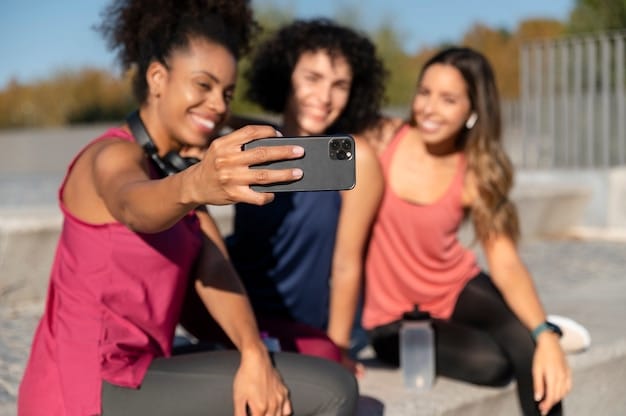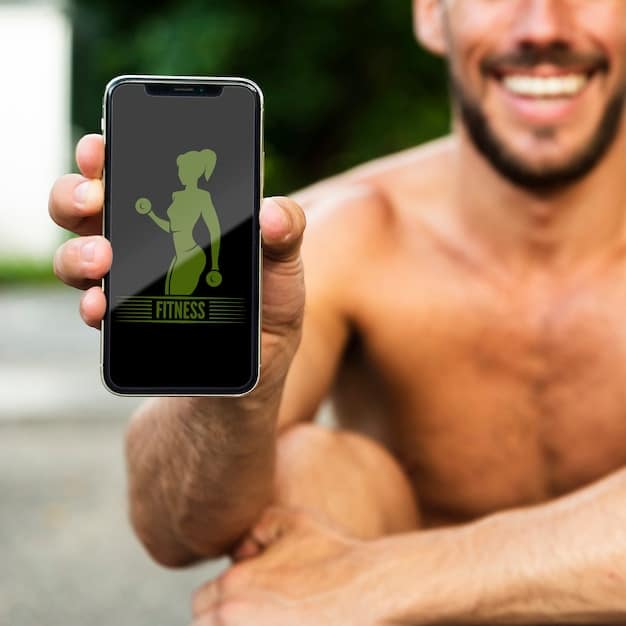Athlete Endorsements: How Many Followers to Earn $10,000?

The Impact of Social Media on Athlete Endorsements: How Many Followers Do You Need to Earn $10,000? The earning potential for athletes is significantly boosted by social media, but the number of followers required to secure lucrative endorsements, such as a $10,000 deal, depends on factors beyond just audience size, including engagement, niche, and platform.
The rise of social media has revolutionized the landscape of athlete endorsements. But just how many followers do you need to attract brand partnerships and earn a substantial income, like $10,000? The impact of social media on athlete endorsements: How many followers do you need to earn $10,000? is a question many aspiring and professional athletes are asking.
Understanding the Athlete Endorsement Landscape
Athlete endorsements have long been a staple of sports marketing. However, the digital age has amplified their reach and transformed the criteria for selecting athlete ambassadors. Social media provides athletes with a direct line to their fans and potential customers, making them valuable partners for brands seeking to connect with specific demographics.
Traditional vs. Social Media Endorsements
Traditionally, athlete endorsements were largely based on performance, popularity, and marketability through conventional media channels. Today, social media influence has emerged as a critical factor, offering brands quantifiable metrics to assess an athlete’s value. This shift empowers athletes with strong social media presences to secure endorsements, even if they aren’t mainstream superstars.
The Power of Social Media Metrics
Social media engagement, reach, and audience demographics now play a significant role in determining an athlete’s endorsement potential. Brands are increasingly focused on the ability of an athlete to drive awareness, generate leads, and ultimately boost sales through their social media activities.

Here are key social media metrics brands scrutinize:
- Follower Count: The total number of followers an athlete has across their social media platforms.
- Engagement Rate: The percentage of followers who interact with an athlete’s content through likes, comments, shares, and saves.
- Reach: The number of unique users who see an athlete’s content.
- Demographics: The age, gender, location, and interests of an athlete’s audience.
In conclusion, the athlete endorsement landscape has evolved significantly, with social media becoming a dominant force. Brands now prioritize metrics like follower count, engagement rate, reach, and audience demographics when assessing an athlete’s endorsement potential.
Estimating Endorsement Value: A Breakdown
Determining the exact number of followers required to earn $10,000 in endorsements is complex and varies widely. Several factors influence an athlete’s earning potential, including the sport they play, their niche, their engagement rate, and the platforms they use.
Factors Influencing Earning Potential
While follower count is often the first metric considered, it’s not the only determinant of endorsement value. Engagement rate, niche relevance, and the specific social media platform play crucial roles. A smaller but highly engaged audience can often be more valuable than a large but passive following.
Understanding Engagement Rate
Engagement rate reflects the level of interaction an athlete’s followers have with their content. A high engagement rate indicates that an athlete’s audience is genuinely interested and responsive, making them more attractive to brands seeking authentic connections with consumers.
Key elements that impact engagement rate include:
- Quality of Content: High-quality, engaging content that resonates with the target audience.
- Consistency: Regular posting schedule to keep the audience engaged.
- Interaction: Responding to comments and messages to foster a sense of community.
- Relevance: Content that aligns with the athlete’s brand and the interests of their audience.
In summary, estimating endorsement value requires a comprehensive approach that considers follower count, engagement rate, niche relevance, and the specific platform used. A high follower count alone does not guarantee lucrative endorsements; engagement and relevance are equally important.
The Role of Niche and Sport
An athlete’s niche and the specific sport they play significantly influence their earning potential on social media. Certain sports and niches attract more lucrative endorsement deals due to their inherent marketability and the demographics of their fan base.
Popular Sports vs. Niche Sports
Athletes in popular sports like basketball, football, and soccer typically command higher endorsement fees due to their larger and more diverse fan bases. However, athletes in niche sports like skateboarding, surfing, or esports can also earn substantial income if they cultivate a dedicated and engaged following within their specific community.
The Power of Niche Communities
Niche communities often exhibit higher levels of engagement and loyalty, making them attractive to brands seeking to target specific demographics. For example, a competitive video gamer with a strong following on twitch and YouTube may have great results promoting gaming-related products to their audience.
Consider these factors when examining the role of niche:
- Target Audience: The demographics and interests of the athlete’s fan base.
- Brand Alignment: The compatibility of the athlete’s personal brand with the values and target market of potential sponsors.
- Marketability: The overall appeal and attractiveness of the sport or niche to advertisers.

In conclusion, the role of niche and sport cannot be overstated. While popular sports often command higher endorsement fees, athletes in niche sports can also earn substantial income if they cultivate a dedicated and engaged following within their specific community, which is something that endorsement deals appreciate.
Platform Matters: Choosing the Right Social Media
The social media platform an athlete uses can significantly impact their earning potential. Different platforms attract different demographics and offer varying opportunities for monetization. Choosing the right platform is crucial for maximizing an athlete’s reach and engagement.
Instagram: Visual Storytelling
Instagram is primarily a visual platform, ideal for athletes who can create engaging photos and videos. It’s particularly effective for showcasing lifestyle, training, and behind-the-scenes content. Instagram is popular among younger demographics and is well-suited for brand collaborations and sponsored posts.
TikTok: Short-Form Video Dominance
TikTok has emerged as a powerful platform for reaching a wide audience through short-form videos. It’s particularly effective for athletes who can create viral content, challenges, and comedic skits. TikTok is popular among Gen Z and offers opportunities for brand partnerships, sponsored content, and e-commerce integrations.
X (Formerly Twitter): Real-Time Engagement
X (formerly Twitter) is a real-time platform ideal for athletes who want to engage with fans, share opinions, and provide live commentary on games and events. It’s particularly effective for building a personal brand and sparking conversations. Twitter is popular among journalists, commentators, and sports enthusiasts.
Here’s an example of how choosing the right platform matters:
- For athletes seeking to build their personal brand and engage in real-time conversations, X is the ideal platform.
- For athletes seeking to showcase their lifestyle, training, and behind-the-scenes content, Instagram is the perfect choice.
- For athletes seeking to reach a wide audience through short-form, viral content, TikTok is the go-to platform.
Effectively, choosing the right platform to monetize your career is paramount. Athletes should carefully analyze their target audience, content style, and monetization goals to determine the most suitable platform to boost endorsements.
Strategies for Boosting Follower Count and Engagement
Building a strong social media presence requires a strategic approach that focuses on both follower growth and engagement. Athletes need to actively cultivate their online presence through consistent content creation, interaction, and collaboration.
Consistent Content Creation
Regularly posting high-quality, engaging content is essential for attracting and retaining followers. Athletes should develop a content calendar that includes a mix of photos, videos, stories, and live streams. Content should be authentic, relevant, and aligned with the athlete’s personal brand.
Engaging with Followers
Responding to comments and messages, conducting polls and Q&A sessions, and participating in relevant conversations fosters a sense of community and encourages engagement. Athletes should actively interact with their followers to build relationships and cultivate loyalty.
Collaborating with Other Influencers
Collaborating with other athletes, influencers, and brands can expand an athlete’s reach and introduce them to new audiences. Joint campaigns, guest appearances, and shout-outs can significantly boost follower count and engagement.
A successful boost strategy should consider:
- Ensuring Content Quality: High-quality, engaging content that resonates with the target audience.
- Maintaining Consistency: Regular posting schedule to keep the audience engaged.
- Focusing on Interaction: Respond to comments and messages to foster a sense of community.
- Maintaining Brand Alignment: Content that aligns with the athlete’s brand and the interests of their audience.
Effectively, a boost strategy must focus on authentic engagement, providing value to the audience, and collaborating with relevant partners to expand reach and impact endorsement potential.
Case Studies: Athletes Who Mastered Social Media
Examining successful case studies of athletes who have effectively leveraged social media to secure lucrative endorsements can offer valuable insights and inspiration. These athletes often demonstrate best practices in content creation, engagement, and personal branding.
LeBron James: The Social Media Titan
LeBron James has built a massive social media following through a combination of engaging content, authentic storytelling, and strategic partnerships. His ability to connect with fans on a personal level has made him one of the most sought-after endorsers in the world.
Serena Williams: A Champion On and Off the Court
Serena Williams has used her social media platforms to advocate for social justice, empower women, and showcase her personality beyond the tennis court. Her authentic voice and commitment to social causes have resonated with fans and brands alike.
Cristiano Ronaldo: Global Icon
Cristiano Ronaldo is one of the most followed individuals on social media, leveraging his massive platform to promote his personal brand, endorse products, and engage with fans around the world. His strategic approach to content creation and engagement has made him a social media powerhouse.
A key element to these case studies are:
- Authenticity: Expressing true personality and passion.
- Consistency: Posting regularly and maintaining engagement.
- Strategic Partnerships: Collaborating with brands that align with their values.
- Engagement: Interacting meaningfully with followers.
Analytically, the stories of athletes demonstrate the power of social media for building personal brands, driving engagement, and securing lucrative endorsement deals.
| Key Point | Brief Description |
|---|---|
| ⚽ Impact of Followers | More followers often lead to greater endorsement opportunities. |
| 📣 Engagement Matters | High engagement rates can offset a smaller follower count. |
| 🎯 Niche is Key | Specific niches can be highly valuable for targeted endorsements. |
| 📱 Platform Choice | Using the right platform boosts earning potential. |
FAQ
A higher follower count often increases an athlete’s appeal to brands, as it indicates a broader reach and greater potential exposure for the brand’s products or services.
An engagement rate of 3-5% is generally considered good, while rates above 5% are considered excellent. Engagement rate is calculated as the percentage of followers who interact with content.
Niche sports can offer lucrative endorsements within their specific market. Brands targeting those niches find higher engagement, making athletes valuable even with fewer overall followers.
It depends on the athlete’s content style and target audience. Instagram is great for visuals, TikTok for short videos, and X for real-time engagement.
Consistent content creation, actively engaging with followers by responding to comments, and collaborating with influencers can boost follower engagement effectively.
Conclusion
In conclusion, determining the exact number of followers required to earn $10,000 in athlete endorsements is multifaceted. While follower count is a significant factor, engagement rate, niche relevance, the specific social media platform, and strategic brand building play vital roles. Athletes who prioritize authentic engagement, provide valuable content, and actively cultivate their online presence are more likely to attract lucrative endorsement deals.